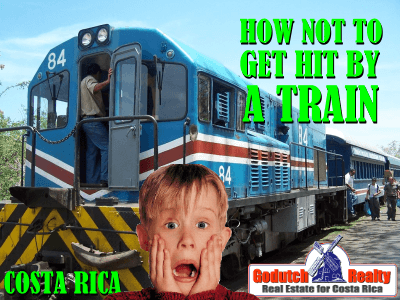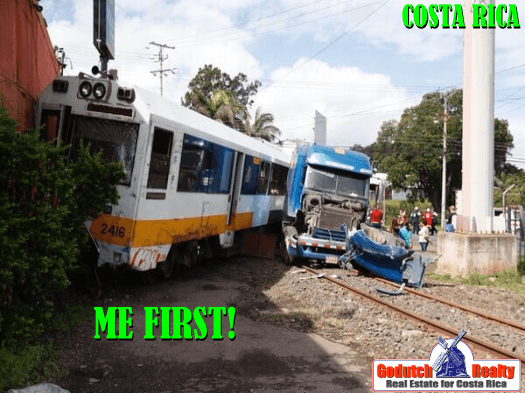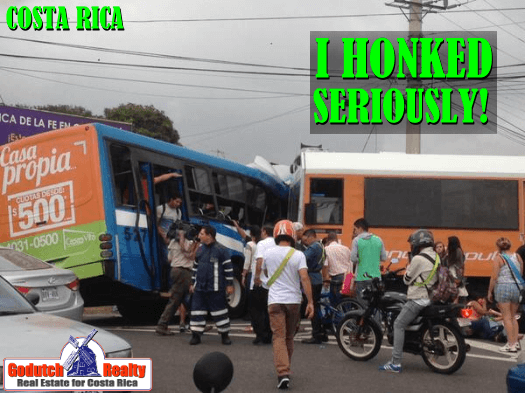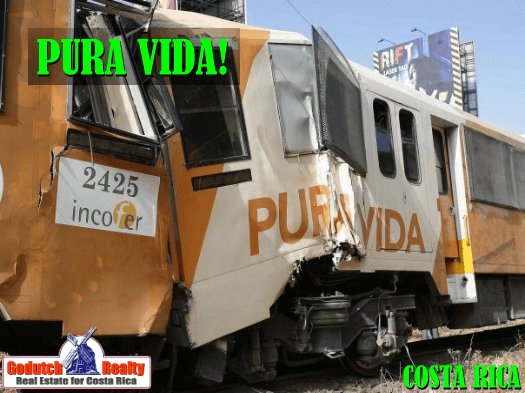 The train was such a wonderful way of transport to a country like Costa Rica. Costa Rica does not have any heavy industries at all, but the country exports a lot.
The train was such a wonderful way of transport to a country like Costa Rica. Costa Rica does not have any heavy industries at all, but the country exports a lot.
Therefore, for many years, the train was very important. Until Jose Maria Figueres closed the railroad in his government. The train stopped running.
Now, the younger generations only know the railroad tracks at something that’s there, but not used.
During Oscar Arias’ 2nd government, in 2008, he put the national railroad company, INCOFER, back into life for certain urban San Jose areas.
And the problems started.
If you come from a country where railroads and crossings are safely organized, you have to read this blog.
The Past
Coffee and bananas were the main export products. almost everything that is shipped in and out of Costa Rica went through to the ports of Limon (Atlantic) and the port of Caldera (Pacific). Before containers became fashionable, everything was transported by train, a situation that has now changed tremendously.
Before that happened, there was still space in the streets on San Jose, Cartago, Alajuela, and Heredia. Now you can get hit by a train if you are not aware there is one.
Driving
Driving in Costa Rica is easy to learn without getting scared. Stay safe by reading my blogs about
- Traffic lights,
- No-passing zones,
- Road obstacles,
- Sidewalks,
- Traffic accidents and
- How we drive over the dead
Two ways to stay safe
You can get hit by a train in Costa Rica in two ways:
1. Do NOT stop on tracks. Watch before you make a turn and don’t drive with earplugs. Only then you can hear the train honk.
2. Before you purchase Costa Rica real estate, make sure the property is not invading the railroad tracks and setbacks. Check the survey and measure the property. If you’re unsure, hire a surveyor.

The train is coming
Ding ding ding ding ding….. the train is coming. Didn’t we all grow up with that sound? Where I come from, trains come through fast so you don’t even want to try to get across to gain a couple of minutes.
Besides, the railroad crossings are all well-protected by:
- Railroad crossing signals
- Flashing lights,
- The ding ding ding sound and
- A barrier that closes so you can’t get across.
Crossings
I have spoken in other blogs about culture bumps. A more dangerous bump is the railroad track that Ticos often do not respect. The barrier, when it’s down, doesn’t stop all drivers. They just drive around it.
Most railroad crossings look abandoned at first sight. They just don’t have any barriers. So although the train makes a lot of noise honking his way through, be careful to make a sharp turn over a railroad crossing. Check first if the train is coming or not.

Very Slow
Thankfully the trains in Costa Rica do not speed; they’re more like a tram. Especially in some parts of San Jose, the tracks go crisscross through the streets. In Heredia, there are some streets where the tracks take up most of the road. AND, the tracks are sticking out quite a bit as shown in the photo of the bus who tried to get across.
Trains don’t run outside the Central Valley. You will find unused tracks everywhere in the ports of Puntarenas and Limon and between those cities and San Jose.
Incofer
In Costa Rica, the railroad has always been run by a governmental institution, Incofer – Instituto Costarricense de Ferrocarriles. Costa Rica’s President Jose María Figueres shut down the heavily indebted railway in June 1995, when at the time the railway transported 729,000 tons of steel, corn, wheat, and bananas annually. Many governments did not invest a penny in the railroad system for years, which was totally abandoned. The immediate consequences of this shutdown were the increase of trailers on the roads to over 4,000 and most have to go through San Jose to get to another city.
In 2008, during the 2nd Oscar Arias administration, the trains started running again, but now only for passenger transport, starting from San José to Pavas and Curridabat, and then to Heredia and Cartago, and soon to go to Alajuela, as soon as they’re able to re-build.
Carlos Alvarado’s 2018 government is proposing a metro for the Greater Metropolitan area. Getting the funds together is much more work than the promise.

Real estate and the railroad
The hardest part to get the commuter train running was the abandoned railroad tracks. The railroad track is public domain. Unfortunately, many homeowners added that land to their back gardens, because the train wasn’t running.
I have seen properties for sale where the railroad tracks had totally disappeared and a wall built on the other side of the track to add the land to their patio. Of course, their formal plot map did not show this land to be included in their property. Unknowing buyers are nicely scammed by these sellers. Closing attorneys never visit the property, so nobody will find out until Incofer claims the public domain.
When Incofer reinstated the railroad, they had to start building from scratch everything that is needed to build a track. In Curridabat for example, you will find condominiums that were built (and sold to unsuspecting owners) who now have a noisy train run right behind their house. In some smaller locations, the building that was the train station was taken over by squatters and turned into pulperías and homes.
My Opinion
Today’s lesson: Driving in San Jose is something that most of us need to get used to unless you’ve driven in Paris or Rome.
Watch out for the railroad tracks when driving. If you are in the market to purchase Costa Rica real estate, use a GoDutch realty agent. Then, for sure, you won’t be paying for a piece of railroad track that won’t be yours.
If you like this blog, subscribe to my newsletter by clicking the banner below.
I DO want to remind our readers that we appreciate any referrals you can send us. Also, please remember the GoDutch Realty agents when you talk about your home in Costa Rica, we appreciate it.

























